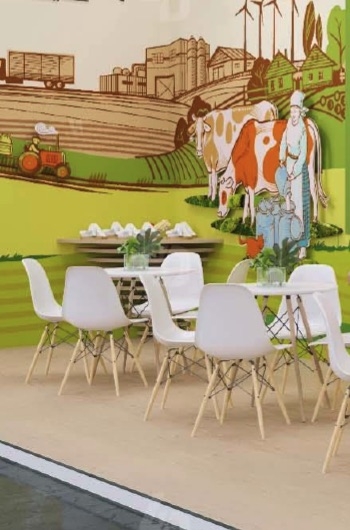Design of exhibition stands: Do you need author's design?
The author’s design of the exhibition stand - why, what and how to fill?

Why a Custom Exhibition Stand Design is Necessary
Showcasing products and services, attracting the attention of potential partners and future clients—these are just some of the marketing and branding objectives that a professionally designed exhibition stand with a unique design can achieve. Participating in exhibitions is an essential part of a marketing strategy for growth in any industry. Despite rapid technological advancements, there is currently no more effective way to promote a brand than displaying a product "face-to-face." There are numerous technical solutions and concepts for designing and filling exhibition stands, but to achieve success in project implementation, maximize return, and ensure profitability from advertising investments, serious preparation is necessary, and professional assistance is often indispensable.
Development Stages: From Idea to Implementation
The project development is carried out in close collaboration with the client’s representatives, focusing on addressing specific business objectives. Typically, the project follows these steps:
- The creation of a future exhibition stand begins with a briefing, where the main business objectives are discussed, the company’s specifics are analyzed, the marketing strategy is clarified, and key goals set by the client are determined. Pricing and deadlines are discussed, along with examples of exhibition stands. The goal of the briefing is to form a technical specification and approve a design concept that best meets all client requirements while reflecting their uniqueness.
- Next comes the design development phase. This usually involves a series of project solutions, each presented with 3D visualization. It takes into account not only the dimensions and capacity of the space but also fits within the virtual exhibition environment, based on the creative idea conceived during the briefing. The exterior and interior are also approved. Functional and design elements, zoning—these are all crucial aspects that developers will carefully consider.
- Approval of the design project with the client. At this stage, final adjustments are made to decorative elements and graphics, and the costs of various solutions are discussed.
- The final development stage is the project documentation, which includes construction drawings, lighting schemes, and other technical solutions.
Examples of Exhibition Stands and Types of Designs
A modern approach involves having at least three zones:
- Presentation Zone, where promotional materials and exhibits are displayed. This is the primary area that forms the first impression and attracts future clients.
- Negotiation Zone. Depending on the event format, this can occupy up to 50% of the exhibition stand's area. Besides serving as a space for negotiations and deal-making, its design also enhances brand recognition.
- Technical Zones. These include product storage, dressing rooms, and other areas essential for organizing a successful event.
Regardless of the proportion in which you decide to order an exhibition stand and how many zones it includes, all designs can be classified into:
- Linear. The most compact type, featuring a single front-facing side. Suitable for showcasing a small number of products and private negotiations. Example of a 3D design of such a project by the 4D Communication Agency.
- Through Stand, also known as a pocket stand. It features two open sides, attracting more attention and creating volume that encourages visitors to enter. Example of a through stand for ATM at the MIMS Automobility Moscow exhibition.
- Corner Stand. This design has two front-facing sides and is usually placed at the end of an exhibition row. It offers visibility from two sides and has greater capacity than a linear stand. See an example here.
- Two-story Stand. This stand is memorable for its scale, helping a brand stand out and attract partners. The second floor can be used for private negotiations or an open area with a panoramic view of the exhibition. Example for ATM at MIMS Automobility Moscow 2024.
Conclusion
The main goal of participating in exhibitions is to attract visitors' attention while minimizing additional advertising costs. Therefore, the design of the exhibition structure is a key element that determines the event's success and the return on investment in brand promotion.
Planning to promote your company at forums, expos, and exhibitions? We are ready to design an impressive exhibition stand, create a 3D design project, and provide full support. Contact us via Telegram, WhatsApp, or call +7 (812) 292 68 09 to schedule a meeting and discuss the project in detail. We are also happy to consult you on any questions regarding concept development, branding, and the design of trade and exhibition spaces.



